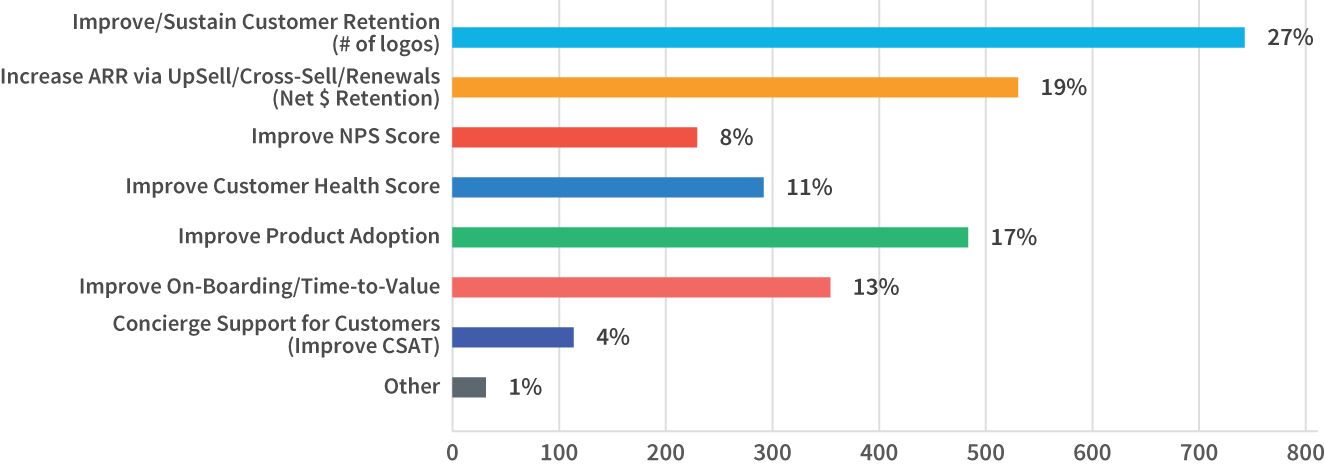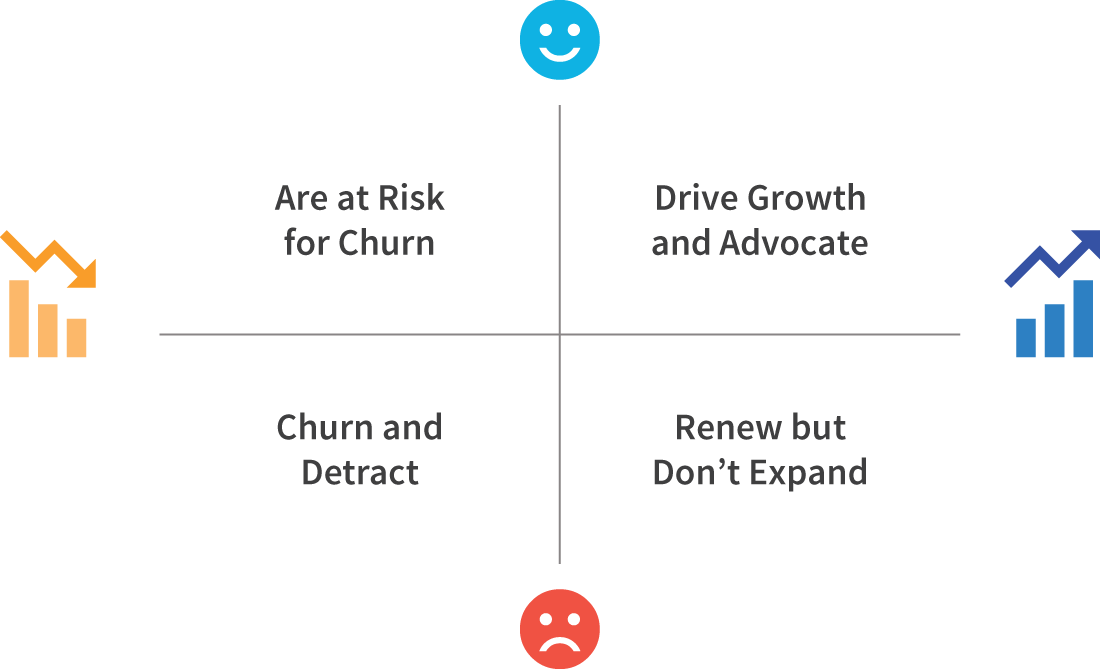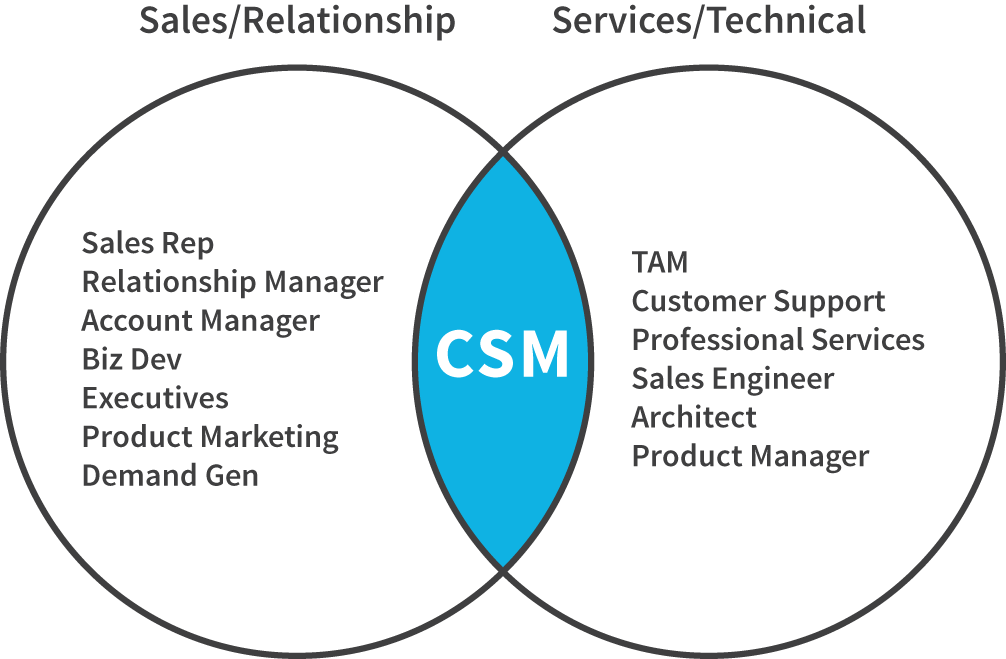2
Defining the Customer Success Manager Role
Customer Success is the business methodology of ensuring your customers achieve their desired outcomes while using your product or service. Customer Success Management is the process of proactively orchestrating and managing toward your customer's achievement of their desired outcomes. It aims to align client and vendor goals for mutually beneficial results. It logically follows then, that: “A Customer Success Manager is the qualified individual that engages with the customer, acutely assesses their needs, strategically aligns the use of your products or services to achieve those needs, and ensures that the customer attains their expected outcomes by tactically and proactively taking actions all along the way.”
Goals: Increase Retention, Reduce Churn, Drive Growth
As a Customer Success Manager, retention is the most crucial thing you will be measured on. Technically, retention means the rate at which you keep your customers over a certain period and the revenue associated with your customer contracts. Retention is not just the act of keeping a customer. It is a process that starts with Sales but lands mostly on you, the CSM, to foster the customer to be successful with your product or service. Your purpose, simply stated, is to help a customer stay your customer.
Why? Because in the digital subscription-based age, the relationship can sometimes terminate with a click of a button. The cost of acquiring new customers can be expensive, and customer retention is a sign of the financial strength of your organization. Therefore, from the beginning of the customer relationship, you want to make sure that your customers are educated, engaged, and active because a highly engaged customer means high customer retention.
The opposite of retention is churn. In the subscription and Customer Success world, “churn” is a four-letter word! Churn means a customer has decided they no longer want to be your customer. It is the complete opposite of retention, and it is your primary responsibility as a CSM to prevent it.
The Customer Success Manager is the frontline of modern organizations and often the individual operationally responsible for preventing customer churn. In SaaS companies, the CSM's primary charter is to ensure the renewal event is essentially a non-event. CSMs are also responsible for building customer loyalty, improving satisfaction, raising customer advocacy, increasing product adoption, and driving growth and revenue expansion. CSMs are expected to do it all! It's a vast scope of responsibility. As a result, most CSMs are constantly challenged to balance all their duties and objectives on a day-to-day basis.
Fortunately, Customer Success leaders are learning to prioritize the charters of their CS teams. In a 2019 Gainsight survey that benchmarked the Customer Success category, more than 900 respondents shared the top three most important objectives of their customer success team (Figure 2.1).
Surprisingly, improving the Net Promoter Score (NPS) was not even in the top five, and improving customer satisfaction was at the bottom. Pause and think about that for a moment. Although customer success leaders care about NPS and CSAT (Customer Satisfaction surveys), their primary focus is on generating higher customer retention rates, revenue growth, and improved product adoption. Fortunately, the CSM is in the perfect position to drive towards these objectives.

Figure 2.1 Gainsight 2019 Customer Success industry benchmark Survey.
The Consumption Gap
In his book, Complexity Avalanche, J.B. Wood acutely describes a core challenge facing today's technology companies, and therefore Customer Success Managers. Wood states that “if your end customers can't figure out how to use your product or they can't get it to work in their network, or they can't change their business process to adapt to its features, it has little or no value to them.”1 He goes on to explain that “the difference between the value of the product could provide to the customer and the value it actually does provide is what we call the ‘consumption gap’ (Figure 2.2). The ultimate goal today is to enable customers and their businesses to get full value out of the product.”
Figure 2.2 first aims to point out what is possible with your product versus how your customer is actually using it. The assumption is that the more your customers leverage and use your product to attain their desired outcomes, the less likely they will churn. The goal, of course, is to shrink that gap over time. The second inference of this graphic is that your product and development teams are busy at work creating new features and enhancements, thereby widening the gap with every new release. CSMs work from within an often-fluctuating consumption gap.
The symphony of movement within the consumption gap creates a number of opportunities. For example, new product features often create different and better use-cases for existing customers to derive additional value. New features can also mean new upsell and expansion opportunities if priced separately from the base product. A piece of advice: you should always be working for a company that is continuously innovating and raising the bar on what is possible with your product. Assuming that is the case, one of the most challenging aspects of being a CSM at a fast-growing and innovative company is keeping up with all of the advancing product capabilities. To serve your customers properly, you must know your product extremely well. Only then will you be able to close the consumption gap to the benefit of your customer and your company.

Figure 2.2 The consumption gap (Wood 2009).
The Customer Success Equation
Customer Success is the belief that “We only succeed if you succeed.” When you can demonstrate to your customers the value of their engagement by helping them attain their desired Customer Outcomes (CO), they will more eagerly renew, expand, and advocate on your behalf. Customers are truly the sleeping giant of your revenue stream, and your customer success efforts have the potential to create a growth engine entirely cultivated from existing customers. However, Customer Success is only a portion of the success equation. Customer Experience (CX), is a separate discipline that develops happy and satisfied customers. However, what happens when your happy customer doesn't attain their desired outcomes?
Customer Success is the combination of the customer's experience as they attain their desired outcomes. When you have one without the other, the results are not optimal. The customer must derive value from your product or service. Customer Success is not about customer satisfaction. It is not about customer delight. It is about delivering value with a wonderful experience.
Figure 2.3 is a 2×2 illustration that helps visualize the relationship between Customer Experience and Customer Outcomes.
The horizontal (x-axis) reflects the measure of delivered outcome to the customer's expectations. The vertical (y-axis) demonstrates the degree of positive experience from the customer's perspective. As with most 2×2 management consulting charts, you always want to be in the upper-right corner. In this case, you've delivered on your brand promise, helped the customer attain their desired outcome, and have done so by giving them an awesome experience all along the way. A customer in any other quadrant is at risk of churn.
The upper-left quadrant is an interesting one. It represents customers that have a great experience engaging with your company (e.g. great people, amazing team, easy to work with, or highly responsive) but it has failed to deliver the business results the customer expected. Customers in this quadrant are often misclassified as “healthy.” They may even give you a 9 or 10 on an NPS survey. However, in this case, the sentiment signal is a false positive.

Figure 2.3 Customer Experience and Customer Outcomes. (Gainsight)
Similarly, customers in the lower-right quadrant attained their desired business results, but they didn't have an optimal experience with your company. While they may not churn, they likely won't expand their engagement with you. If their experience was poor, they will begin looking to your competitors, who all claim they can deliver equal, if not better results, and likely for less money and with a far better experience.

A snapshot of customer satisfaction.
We have established that your goal as a Customer Success Manager is to deliver customer outcomes with a great experience. However, there is one stakeholder that is missing from the ![]() equation: your company. Recall, customer retention and increasing revenues are the two most essential objectives of Customer Success teams from a CS-leader's perspective. As such, there is a strong likelihood that you, as a CSM, will be measured by customer retention rates and revenue growth that is derived from the portfolio of customers you manage. Simply put, you want your customers to remain customers and buy more stuff from you. You are helping to deliver the variables for success not only for your customers but also for your company. However, how do you balance delivering success for your customers while also attaining your company metrics?
equation: your company. Recall, customer retention and increasing revenues are the two most essential objectives of Customer Success teams from a CS-leader's perspective. As such, there is a strong likelihood that you, as a CSM, will be measured by customer retention rates and revenue growth that is derived from the portfolio of customers you manage. Simply put, you want your customers to remain customers and buy more stuff from you. You are helping to deliver the variables for success not only for your customers but also for your company. However, how do you balance delivering success for your customers while also attaining your company metrics?
During an internal company-wide gathering, our leader, Gainsight CEO Nick Mehta responded to a similar question about our investor, stakeholder, and strategic objectives. His answer was magnificent and is paraphrased here: “In order to have the opportunity to help our customers attain their success, we also have to be successful in business. Otherwise, we won't have the opportunity to engage new and existing customers. It's a golden circle of sorts. You can't have one without the other.” Nick was spot on. Customer Success is a vital element in this new way of thinking. The way a customer feels about their experience at the end of their contract in light of the results you helped them produce can fuel growth and more opportunity to help more customers.
What Customer Success Management is Not
While we have addressed what a Customer Success Manager is, it is equally important to know what it is not. We learned earlier that there could be a mountain of various expectations placed on CSMs. Figure 2.4 illustrates the unique space that Customer Success Managers are taking in the modern organization. There can also be an overlap in skills and responsibilities that make the CSM appear like a newer version of support or account management, for example.
It is helpful to clarify the definition of a Customer Success Manager further, by contrasting what a Customer Success Manager does not, or rather should not, entail.

Figure 2.4 What Customer Success Management is/is not (Gainsight).
Not Customer Support
Customer Support is hugely important to the customer ecosystem. However, it is mostly transactional, focused on break/fix interactions, and is almost always reactive in nature. In the foundational CS industry book, Customer Success: How Innovative Companies are Reducing Churn and Growing Recurring Revenue, Nick Mehta and Dan Steinman keenly acknowledge “both organizations [support and customer success] are 100% needed to be effective as a company. The admonition here is to be mindful that they are not designed to accomplish the same goals.”2
Customer Success focuses on the longitudinal relationship, not the transactional one. Applying the Pareto principle, commonly known as the 80/20 rule, 80% of CSM activity should be proactive, and 20% reactive. If that formula is inverse at your company, it's not Customer Success. You and your company's leaders need to be honest and call it what it is: escalated Customer Support. Simply renaming an organization as “Customer Success” will not yield different behaviors nor different outcomes.
Not Account Management/Sales
Sales and Account Management engagements are, at their core, financially driven, heavily incentivized, and mostly transaction-based. Importantly, the individuals in these critical roles typically only engage at account-level milestones, such as contract renewals, paid professional services engagements via Statements of Work (SOW), or expansion opportunities. While their methods have elements of relationship-building and they help to align your company's products to solve customer challenges, the pinnacle of the Sales and Account Manager engagement is attained when the prospect or customer completes the commercial transaction. In all likelihood, sales won't re-engage again until there is a new sales opportunity in sight.
The CSM, on the other hand, must foster the relationship throughout the customer's journey, ensuring the customer achieves their expected goal. We will keep saying it many times: when a customer attains their desired outcome while having a great experience, they will inevitably buy more from you. While it may not be your primary duty to manage the commercial aspects of your customer, you are indeed doing all of the heavy lifting to make any future transactions justifiable. As a CSM, whether you realize it or not, you are constantly selling your solution through the results it produces. Your successful efforts will lead to more commercial transactions in the form of renewal, an expansion, a referral, or all three.
A Career or a Springboard to a Real Profession?
It is absolutely true that Customer Success Managers often launch into other roles after “putting in their time.” There is a reason for this phenomenon. CSMs are some of the most capable people on the face of the planet. Yes, we are a little biased. However, the simple truth is that the role affords you a rare opportunity to learn and understand how your customers think and how they work with your products at a truly intimate level of exposure not typically granted to Marketing, Sales, Support, or Product. As a result, you become a sort of hot commodity inside and outside of your company. Growth opportunities abound for really effective and successful CSMs. We have seen and heard of Customer Success Managers moving into literally every department – Training, Marketing, Product, Analytics, Operations, Consulting, Professional Services, HR, and more. We have also seen CSMs, perfectly happy to remain as individual contributors, managing their dynamic portfolio of customers.
Skilled people can advance very fast, especially where experienced CS professionals are in short supply. That is pure supply and demand economics. We even know of a few people that have gone from Customer Success Manager to Chief Customer Officer in a relatively short period of time. Of course, there is always another side of the coin. The visibility of Customer Success continues to increase every day. Inside the companies that have a successful CS practice, there is a growing level of attention that comes onto the function, even to the individual CSM. If you are okay with a job where the CEO asks, in good or bad circumstances, “Who is the CSM on that account?” you'll be just fine. It is the nature and rising importance of the function. And that's a great thing if you are an aspirational person.
For the record, we ascribe to the notion that the Customer Success Manager role can be a great catalyst for other opportunities. We both have launched into different positions and management roles after being individual contributing CSMs with our own assigned portfolio of customers. We didn't leave the function because we didn't like it. Instead, it was a passion for the opportunity to improve the profession, the Customer Success Manager function, and its impact on our customers and the greater CS community that drove us to pursue related opportunities. Hence the question “Is a Customer Success Manager, a career or simply a springboard to a real profession?” To answer, we asked industry icon Jon Herstein, Chief Customer Officer at Box, to provide his perspective on this specific topic.
While software professions like Product Management, Sales, Consulting, and others have been around for decades, the Customer Success arena is still relatively new. It's pioneer days for those Customer Success Managers who have already decided that being a CSM is their “calling.” They will thrive at the forefront of the subscription-driven Customer Success movement and they will become the first generation of senior leaders who “grew up” (professionally) as Customer Success practitioners. Today's CCOs come from varied backgrounds. Tomorrow's CCOs will almost certainly be former Customer Success Managers who will run their organizations with the benefit of their hard-won experience as professional Customer Success Managers.
